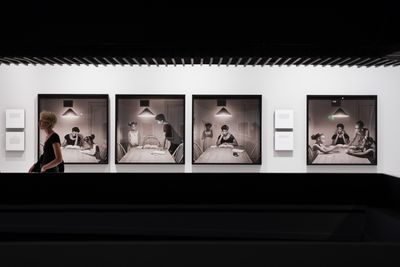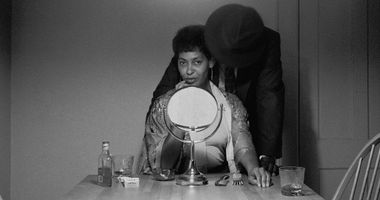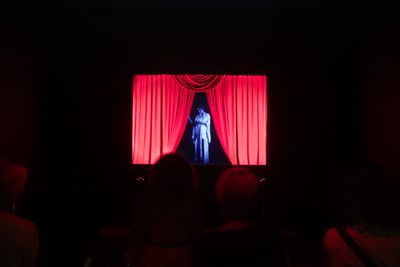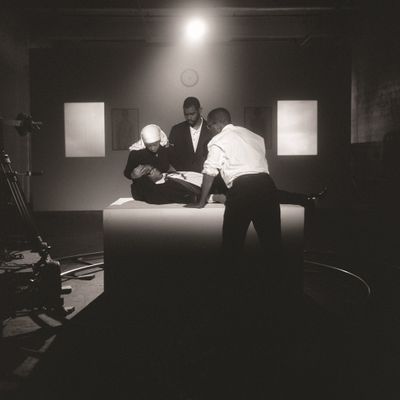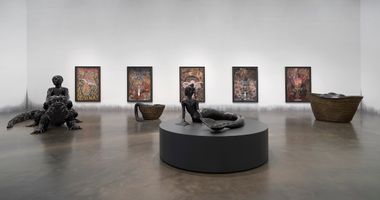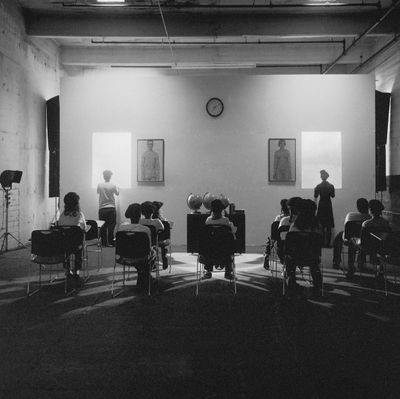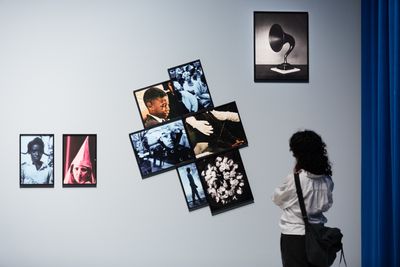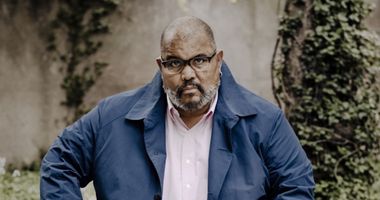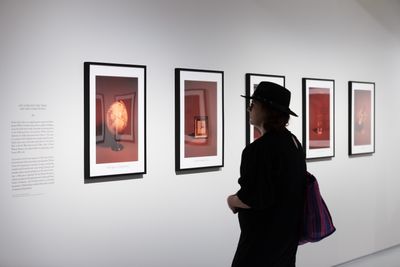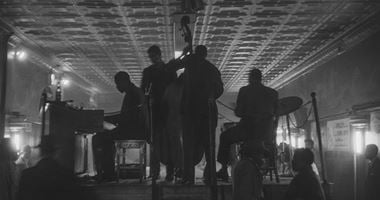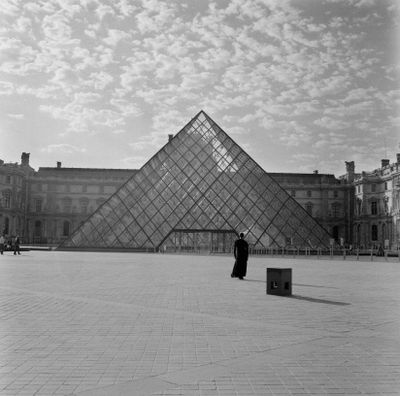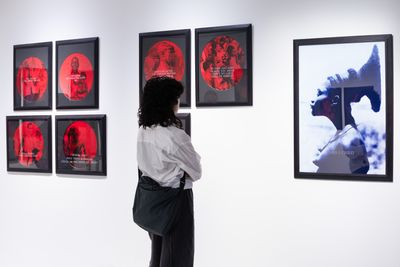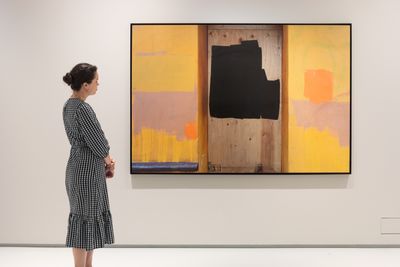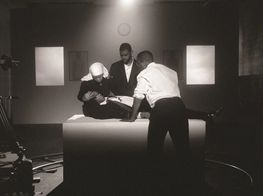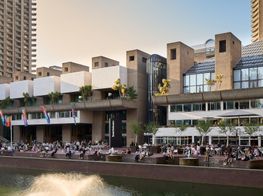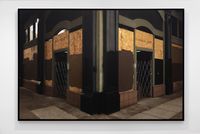Carrie Mae Weems: Agency Reclaimed

Exhibition view: Carrie Mae Weems, Reflections for Now, Barbican Art Gallery, London (22 June–3 September 2023). Courtesy Barbican. Photo: © Jemima Yong.
Rolling percussion, song, and spoken word are among the ambient sounds that accompany viewers as they make their way through Carrie Mae Weems' immersive survey at the Barbican in London.
Reflections for Now (22 June–3 September 2023) is composed of photographs, installations, and films that reflect the multidirectional passages of history, memory, and cultural identity that Weems has explored over the course of four decades.
From the artist's seminal 'Kitchen Table Series' (1990) to more recent photographic and video works highlighting structural violence in the United States, the exhibition interweaves past and present works across two floors of the Barbican to reflect the complexities of human experience in relationship to power.
Entering the exhibition, the reception area is softly lit and lined with white curtains, offering a poetic space from which to embark on a journey through the artist's practice. Acting as a guide throughout, Weems inhabits various personas, appearing both before and behind the camera, drawing upon her experience as a Black woman in the United States and the historical realities impacting the experiences of others to highlight their exclusion and erasure.
Across the exhibition, the personal and political interconnect through works that are cinematic and performative in nature, with Weems' love of music shining through. One such example is the immersive installation Lincoln, Lonnie, and Me – A Story in 5 Parts (2012), presented in a darkened room on the exhibition's ground floor.
Weems explains that while personal elements that make autobiography appear to be key, 'it's always about something larger.'
Here, thick red curtains are pulled back to reveal imagery that hovers and fades against a pane of mylar, which warps projections of video excerpts. Intermitting segments of gently falling snow and clouds of smoke fade and slip into view, reflecting on the fracturing of democracy and the positioning of Blackness in Western historical imagination.
The layered film pivots around the artist, Abraham Lincoln, and photographer Lonnie Graham, and is staged in a manner reminiscent of 19th-century theatre. The projection technology was inspired by the 'Pepper's Ghost'—an optical trick of the era involving the 'ghost' image of actors within the orchestra pit appearing to audiences on a sheet of glass.
The film opens to bluesman Blind Willie Johnson's 1927 song, 'Dark Was the Night, Cold Was The Ground' while a figure tap dances between the curtains. Tap originated as a percussive dance form when slave owners banned instruments, and became appropriated in travelling minstrel shows that mocked enslaved individuals through blackface.
In her film, Weems' tap-dancing figure appears both liberated and weighted within Johnson's mournful tune, only to be intercepted by later imagery, including some recognisable from the series 'Constructing History' (2008), visible upstairs in the exhibition.
Both a film and photographic project, 'Constructing History' was organised with students from the Savannah College of Art and Design in 2008 to re-enact major historical events from the 1960s. Weems looked back at events of loss and mourning over the 40 years leading up to Barack Obama's running for presidency in 2008, including the death of Malcolm X, Medgar Evers, and Martin Luther King Jr., to consider how they contributed to the formation of the present.
Giving students the agency to assume different roles and research these events, camera dollies, lighting, and surrounding studio space are made visible in resulting photographs. In so doing, Weems makes us witnesses and therefore active participants in history-making.
One such image, The First Major Blow (2008) draws from the assassination of John F. Kennedy, capturing the smiling president and his wife in a car. In Lincoln, Lonnie, and Me, the same image is visible as a slow-moving film across the screen against an audio excerpt of Weems reading Lincoln's 'Gettysburg Address' (1863).
In an interview with Dawoud Bey in the exhibition catalogue, Weems explains that while personal elements that make autobiography appear to be key, 'it's always about something larger.' Her seminal 'Kitchen Table Series' (1990) at the Barbican features 16 photographs taken of the artist at her kitchen table, surrounded by fictional friends, lovers, and children to reflect a narrative of womanhood, alongside 13 text panels.
Weems sought to reinstate [documentary photography's] political and social agency while questioning its assumed neutrality...
A fictional drama plays out as Weems' protagonist grapples with the traditional confines and expectations placed on her in her relationships. While other individuals come in and out of the frames, Weems takes the lead, and over the course of different trials, she finally appears resolute. 'Presently she was in her solitude,' the accompanying text reads, 'so it wasn't nobody's business what she did.'
As Weems emphasises in a film of a lecture on the exhibition's ground floor, working in context with others is as important as tapping into personal experience. She mentions performance artists Ana Mendieta and Adrian Piper, underscoring that their 'acting out in the world' is not 'an abstraction', but vital in highlighting social structures we are blind to.
Born in 1953 in Portland, Oregon, Weems explains to Bey that it was her encounter with the Black Photographers Annual, a Black-published photographic anthology, when she was 18 that showed her the true 'possibility for [herself]—as both subject and artist'.
Roy DeCarava was another key influence, in his rich and refined documentation of Harlem's Black residents, and who had an enormous impact on other African-American artists who were responding to New York's shifting cultural identity.
Among them is the Kamoinge Workshop, a collective of Black photographers with whom Weems became involved when she arrived in the city in 1976, alongside Bey, whom she met at a photography workshop he led at the Studio Museum in Harlem.
In the exhibition catalogue, Weems explains how her first series 'Family Pictures and Stories' (1978–1984) reflects her developing approach to documentary photography. Taken in response to the 1965 Moynihan Report, in which the U.S. Department of Labor blamed 'the deterioration' of Black society on weak family structures, Weems' gaze, both searing and tender, captured candid photographs of her own family.
Inspired by DeCarava's truthful portrayals of Black life, Weems used her family as a 'representational vehicle' to think about the migration of Black families from the South as they sought to escape segregationist laws and pursue economic opportunities in the North. She created rich portrayals of her family's day-to-day life supplemented by text.
In Alice on the Bed (1978–1984), for instance, Weems captures her older sister wrapped in a sheet, gently smiling towards the camera, while the accompanying text frames her strength. 'She's a no jive kinda woman,' it reads, 'taking no slack from nobody for no reason.'
In the 1980s, the role of documentary photography was put into question after the banality assigned to it by Conceptual artists of the 1960s, whose photographs did away with the medium's contingent and contextual potency to represent flat visual data.
Artists such as Weems sought to reinstate its political and social agency while questioning its assumed neutrality and bringing awareness to power imbalances enforced by the voyeuristic lens, thus returning voice and agency to individuals who have been silenced.
It is a thread that runs throughout the artist's work, visible throughout bodies of work shown at the Barbican, and most potently in her series of edited daguerreotypes, 'From Here I Saw What Happened and I Cried' (1995–1996).
Positioned on the exhibition's second floor, Weems originally found the photographs within Harvard University's Museums Archives—a 1850 commission by Harvard scientist Louis Agassiz to support his speculation that human races were created separately.
The images reveal photography's complicit support of racism and harmful stereotyping, further highlighted by their placement alongside more appropriated imagery of African Americans that Weems sourced in university and museum archives.
Weems overlays these images, which have been enlarged, cropped, and placed within circular frames to mimic the camera's lens and manifest the act of looking, with segments of text that speak across history to the individuals portrayed.
In one set of portraits, the text is broken up across the four photographs, and reads, in capitals: 'An anthropological debate' / '& a photographic subject' / 'You became a scientific profile' / 'A negroid type'.
In a quote on the wall in the exhibition space, Weems elaborates on the series—'When we're looking at these images, we're looking at the ways in which white America – Anglo America – saw itself in relationship to the Black subject . . . I use this idea of "I saw you" and "You became" as a way of both speaking out of the image and to the subject of the image.'
Sometimes, absence speaks louder than words. Weems' recent body of work at the Barbican, 'Painting the Town' (2021), resembles carefully composed Colour Field paintings. But a closer inspection reveals photographs of thick strokes of paint on shopfronts and walls.
Taken in her birth town of Portland, Oregon, after the demonstrations that erupted over the murder of George Floyd by police in May 2020, the paint conceals messages made by protestors around the city.
While signalling the act of silencing protestors, Weems also opens a dialogue with the Western art historical canon and its exclusion of Black contributors to Abstract Expressionism, such as Norman Lewis, Sam Gilliam, and Ed Clark.
Here, Weems intelligently manoeuvres material form to encompass layers of loss. Reflecting the exhibition's multi-faceted spiralling across points in history that uphold the oppression of marginalised peoples, through the violently blanked out walls, Weems asks, 'What now?' —[O]

